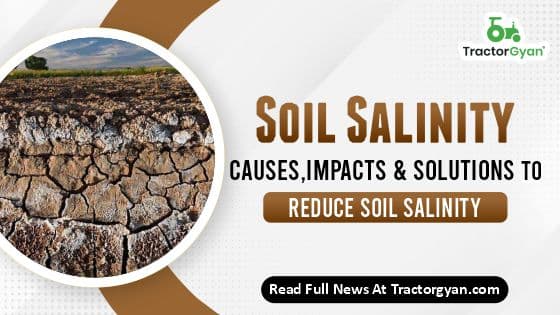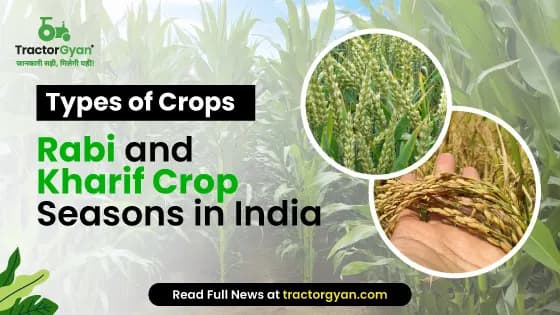What is Soil Salinity? Know about its Impacts & Causes
टेबल ऑफ कंटेंट
Soil salinity is the result of excessive deposition of water-soluble salts in lands. It negatively impacts the land quality and makes it infertile in the long run. Soil salinity affects the development of plants and crops. It further leads to soil erosion if left untreated. Thus, it lowers agricultural production and affects the farmer's economic well-being. But, taking measures to resolve it in the early stages is crucial to improve soil fertility.
So, this article will help you in understanding about soil salinity.
-
What is soil salinity?
-
How to measure soil salinity?
-
Reasons to prevent soil salinity?
-
How to reduce soil salinity? - various solutions to overcome the situation.
What is soil salinity?

Soil salinity is the excessive amount of salt accumulation in soils. This excessive deposition of water-soluble salts in lands is known as the Salinization of soil. A commonly found salt is table salt NaCl. The list is far bigger and includes various compounds of sodium, potassium, calcium, magnesium, sulfates, chlorides, carbohydrates, and bicarbonates. In general, salt-affected lands are differentiated as saline, sodic, and saline-sodic. It depends on the content of the salt deposits.
The major soil salinity effect on plant growth is issues related to water absorption. Even if there is enough soil moisture, crops wade and die due to the inability to take up enough water from the soil. Soil salinity happens by mineral weathering or flood-prone areas or by improper farming practices. While some areas of land are saline due to low salt dissolution and removal.
Reasons for soil salinity - what are the causes of soil salinity?

-
Soil salinity occurs due to dry climates and low precipitations when large amounts of salt deposits are not flushed from the lands.
-
When there is a high evaporation rate in the atmosphere, the land fails to keep moisture which adds salts to the ground surface.
-
Also, when poor drainage or waterlogging occurs, salts fail to pass and are not washed due to a lack of water transportation.
-
Improper farming practices like irrigation with salt-rich water leads to worsening the condition of soil salinity.
-
Also, the removal of deep-rooted vegetation and a raised water table as a consequence adds to the cause of soil degradation.
-
leakage from geological deposits and their penetration into groundwater leads to excess deposition of content.
-
When there is a rise in sea - level, the sea salts seep into lower lands and worsen the condition.
-
Seawater submergence followed by salt evaporation is also one of the causes of soil salinity.
-
Inappropriate application of fertilizers in farming leads to excess nitrification. It accelerates soil salinity.
Different Impacts of Soil Salinity
The impacts of soil salinity affect both ecology and human life. It induces soil degradation, and affects crop production. It induces the risk of floods & decreases terrestrial biodiversity. Moreover, it also has negative effects on below mentioned areas:
-
Agricultural production: When the level of salts in the soil water gets too high, water flows from the plant roots back into the soil. And this results in dehydration of the plant, leading to a decline in yield or even causing the death of the plant. The salt tolerance of some crops relies on their ability to extract water from salinised soils. Salinity affects crop productivity, pastures and trees. It interferes with nitrogen uptake, lowering growth and slowing down plant reproduction.
-
Water Quality: The most important off-site impact of dryland salinity is the salinization of fresh rivers. This affects the quality of water for drinking and irrigation purposes. It leads to serious economic, social and environmental consequences for both rural and urban localities.
-
The ecological health of streams: Salt interacts with and affects in-stream biota (animals and plant species), changing the ecological health of streams and estuaries. The greatest threat and harm to biodiversity is the loss of habitat; both on land and inside water.
-
Terrestrial Biodiversity: Natural vegetation in salt-affected areas has been destroyed or damaged due to soil salinity. And this has caused major changes to the landscape and biodiversity. Moreover, the destruction of remaining natural habitat in many agricultural areas/lands and the fragmentation of many wildlife corridors has also taken place because of increased salt concentration.
-
Soil Erosion: Dryland salinity further leads to other soil degradation issues, including soil erosion. Salinity is usually associated with prolonged wetness and lack of surface cover. It also increases the chances of the vulnerability of soil to soil erosion.
-
Flood risk: Shallow water tables can heighten the risk of flooding. Soils in these conditions have limited capacity to absorb rainfall, resulting in high rates of run-off without absorption. Further, resulting in damage to roads, fences, dams, agricultural land and wetlands.
-
Infrastructure and fixtures: Soil salinity results in major decreases in the lifespan of road pavements when groundwater levels rise to within 2 metres of the pavement surface. The high Salt deposition also corrodes and destroys the properties of bitumen, concrete and brick structures. It also results in damage to infrastructure such as houses, roads, and playing fields in many cities and towns. Soil Salinity damage has also occurred to country roads and farm tracks and buildings.
-
Irrigation: Generally, all irrigation water contains some salts in it. It may remain on the soil surface or the leaves of plants after evaporation. Thus, any irrigation system can deliver an increased amount of salt to the soil during the process.
What are the solutions to reduce soil salinity?
There are several techniques to reduce and prevent soil salinity problems:
-
One should Increase drainage for better flushing. It removes the salt deposit from the ground surface.
-
You can grow salt-tolerant crops to manage economic risks and ensure land cover.
-
Remove salt crystals from the surface to prevent damage.
-
Restore the balance in soils via chemical amendments like gypsum or sulfuric acid.
-
Pre-treat seeds with NaCl to promote seed germination faster
-
Reduce the process of evaporation with mulch or crop residue.
-
Grow crops that can absorb better moisture to avoid prolonged wetness of lands.
-
Use fertilizers , as an overuse of certain chemicals can also promote soil salinity.
Conclusion
Finally, we have discussed all possible reasons, impacts, and solutions for soil salinity. So, now it must have cleared all your questions related to soil salinity. I hope you have got your questions covered. Always take preventive measures to protect your soil from soil degradation or soil erosion.
कैटेगरी
और ब्लॉग पढ़ें
Technology has upgraded almost every aspect of our lives. Agriculture is no exception to this as crop production has increased due to innovative irrigation techniques and advanced machinery. It has also minimised waste and generated more income. One such progressive technology is...
Agriculture is vital for meeting the growing demand for food across the globe. The success of farming depends largely on water availability. In many regions of India, rainfall is insufficient to sustain crops. Traditional methods of irrigation are no longer enough.
This is...
भारतीय किसान आज आधुनिक तकनीक के मदद से अपनी उपज को बढ़ाने और श्रम की बचत करने में कामयाब हो रहे है। कृषि बाज़ार अनेक उपकरणों से भरे हैं जिनको उपयोग में लेकर किसान कम समय में अधिक उपज पा सकते हैं।
पुन्नी...
इसके बारे में अपनी टिप्पणी लिखें What is Soil Salinity? Know about its Impacts & Causes
.webp&w=1920&q=75)
ट्रैक्टर और कृषि से जुड़े सबसे अधिक खोजे जाने वाले ब्लॉग्स
18 Dec 2025
18 Dec 2025
29 Jul 2025
08 Sep 2025
03 Jul 2025
30 Jul 2025
30 Jul 2025
30 Jul 2025
29 Jul 2025
30 Jul 2025
29 Sep 2025
31 Jul 2025
18 Dec 2025
31 Jul 2025















.webp&w=2048&q=75)










.webp&w=2048&q=75)
.webp&w=2048&q=75)



























